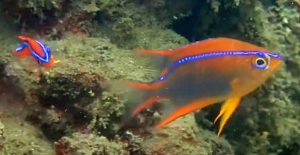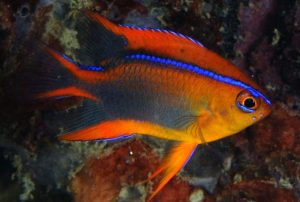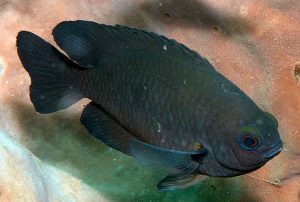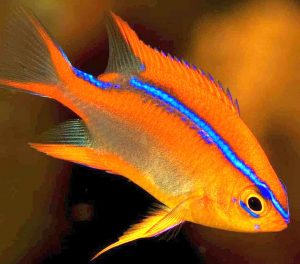Red Honey Damselfish (Neoglyphidodon crossi) known to tropical fish keeping enthusists as Cross’ Damselfish, Orange Honey Damselfish, Cross’s Damsel, Red Honey Damsel, and Red Chromis is found in the Western Central Pacific Ocean around Indonesia, Papua New Guinea, the Philippines, Sulawesi, and the Moluccas.
Red Honey Damselfish are a shy, solitary, non migratory, reef associated species that are normally found alone or in pairs around relatively shallow coral reefs at depths from 3 to less than 50 feet.
Adult Red Honey Damselfish are frequently found swimming near the surface in the shallow gutters of rocky areas and around the coral reefs in protected bays and lagoons.
Juvenile Red Honey Damselfish have an orange to red orange body color with a black bottom and a horizontal blue line that extends from the snout, just over the eye, to the caudal pentacle. The pelvic and anal fins are the same reddish orange color as the body.
As they grow into adulthood, the orange body color becomes more grayish and the vivid blue line becomes less distinct.
Mature adults lose their bright colors and have an overall brown body color.
Red Honey Damselfish can be housed in a mature reef or FOWLR tank of at least 55 gallon capacity with a sandy or finely crushed coral substrate and plenty of live rock arranged into crevices, caves, and overhangs for them to hide among. Although Neoglyphidodon crossi are considered semi aggressive, they are totally reef safe and will not harm corals or invertebrates.
When housed in small tanks, the Red Honey Damselfish will become aggressive to other damsels and clownfish. In larger tanks, small odd numbered groups can be kept together without incident, however, they can often be aggressive towards new fish additions.
Red Honey Damselfish have been bred in an aquarium environment but the fry are difficult to rear.
During the breeding season in their natural habitat, Red Honey Damselfish pair off and after a brief courtship ritual, the female will lay a mass of small adhesive eggs on the substrate. After fertilizing the demersal eggs, the male will guard and aerate the eggs until the larvae hatch out. The tiny fry in their larval stage will drift with the current as plankton feeding on zooplankton and phytoplankton before settling to the bottom as partially developed damselfish.
Red Honey Damselfish are not picky about their food and will aggressively eat a varied diet of meaty and green foods. Live, frozen, or freeze dried Mysis shrimp, brine shrimp, finely chopped clams, fresh fish, Spirulina, herbivore flakes
, etc. will be eagerly accepted. Feeding several times a day is recommended.
Red Honey Damselfish (Neoglyphidodon crossi) are occasionally seen in the aquarium trade but are not a commonly stocked item. Tropical fish keeping enthusiasts can occasionally find them online from wholesalers, trans shippers, and retailers or back order them at prices varying from $14.99 to over $19.99 at the following approximate purchase sizes: Up to .75″, Small: Over .75-1″, Small to Medium: Over 1-1.5″, Medium: Over 1.5-2″, Medium to Large: Over 2-2.5″, Large: Over 2.5-3″, Extra Large: Over 3-3.5″, Extra Extra Large: Over 3.5″.
Minimum Tank Size: 55 gallons
Aquarium Type: Reef or FOLR
Care Level: Easy
Temperament: Semi Aggressive
Aquarium Hardiness: Hardy
Water Conditions: 74-82° F, dKH 8 to 12, pH 7.9-8.5, sg 1.020-1.027
Max size: 3.9″
Color Form: Orange, Red, White, Blue
Diet: Omnivore
Compatibility: Reef
Origin: Western Pacific Ocean, Sulawesi and the Moluccas
Family: Pomacentridae
Lifespan: over 5 years
Aquarist Experience Level: Beginner





